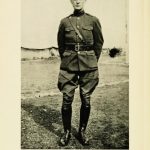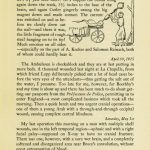A new exhibition from Medical Heritage Library partner Yale University entitled “Yale Medicine Goes to War, 1917″ commemorates America’s entry into the war at the local level. From mobilizing a “first of its kind” Mobile Hospital Unit, No. 39, to research on the effects of chemical warfare, this exhibition explores the many ways that Yale Medical School faculty, researchers, and students contributed to the war effort at home and abroad. The war diaries of Harvey Cushing, a pioneering neurosurgeon and Sterling Professor of Neurology at the Yale School of Medicine (1932–1939), are also on view, documenting the trials and trauma of war, particularly brain damage arising from shell fragments, shrapnel, and gunshot wounds.
We cannot talk about Yale’s involvement in the Great War without mentioning Dr. Harvey Cushing. While he was teaching at the Harvard Medical School, Cushing, who graduated from Yale in 1891 and would later become Sterling Professor of Neurology in the Yale School of Medicine, directed a French hospital at the war front. He meticulously recorded his experience in a set of diaries, currently located in Medical Historical Library, Yale University. In 1936, Cushing published a single volume on his war experiences, derived from his diaries, entitled From A Surgeon’s Journal, 1915-1918.
During the war, Cushing operated on head injuries that contained shrapnel. He developed, with his colleagues, a surgical magnet that could help him reach shrapnel pieces without killing the patient. In From a Surgeon’s Journal, Cushing discusses a difficult removal, and the refitting of the magnet using a wire nail to finally grab an elusive fragment of steel embedded in his patient’s brain. Cushing, who was also an artist, drew a rough sketch of the scene.
Other materials in the Medical Heritage Library on Cushing and the Harvard Unit’s experiences in the war include The story of U.S. Army Base Hospital No. 5, authored by Cushing and published in 1919, and a letter from Cushing published in the Harvard Alumni Bulletin on the bombing of the Harvard Base Hospital in 1917.
The Medical Heritage Library is currently working on a multi-institutional online exhibition that will encompass a larger history of medicine in World War 1. Look for in the coming months!







